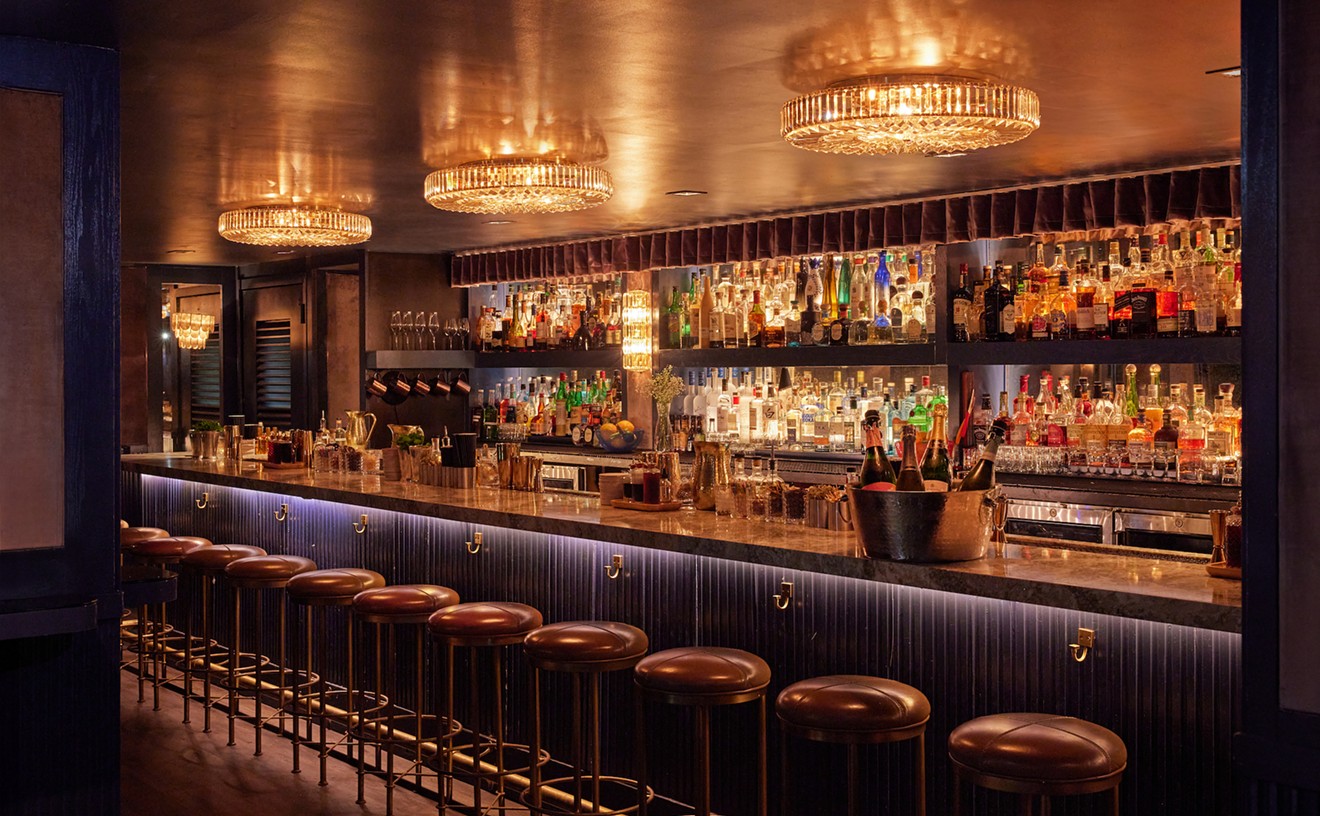But once upon a time each had a specific meaning: Carpaccio, a dish of raw, thinly sliced beef striped with a white sauce, was created at Harry's Bar in Venice and named after a Venetian painter who dramatized his reds with glowing white lines of light. Nowadays it can refer to anything sliced thin. Russian soldiers gave us "bistro," so one story goes, during their occupation of Paris in 1814. In their eating and drinking spots, the famished fellows would yell, "Vee-stra, vee-stra!" meaning, "Fast, fast!" The exhortation (slightly altered) caught on in France as a description of small, informal, neighborhood eateries where one could wander in for a quick bite without making a big dress-up deal of the meal. But a neighborhood restaurant needs a neighborhood, and Brisa Bistro, which opened last September in the Radisson Hotel, doesn't quite have that yet. While locals may someday wander in from their Biscayne Corridor condos (of which some 20,000 are projected), my few fellow diners during four recent visits to Brisa all appeared to be tourists staying at the hotel.
Bistro does indeed seem a strange word for a huge, modern, multilevel restaurant that bears far less resemblance to a little hideaway in the Marais than to the main dining room on a B-class cruise ship. Brisa's ambiance evokes not a bistro but a corporate convention, with what seems like seating for an intimate dinner for 2000. And having to negotiate both the Radisson's "motor lobby" and extensive main lobby to reach the restaurant's formal front desk isn't exactly welcoming to walk-in traffic.
Getting treated like a regular is one of the comforting perks of neighborhood bistros, and this happened when I walked in one Friday night in cross-trainers. Though it was only my second visit, my waiter seemed to sense a computer potato's need for immediate restoration after a gym workout. He brought me a glass of healthful pinot noir, on the house. It was BV, at $11-$16 retail not a boutique pinot but typical of bistro house wines, and a quality quaff for the price, with sufficient soft tannins and a festively fruity/spicy attack. Ladies actually drink free at Brisa on Fridays, from 6:00 to 8:00 p.m. But since I had arrived considerably after 8:00, the comped glass was a very friendly gesture.
The food that followed, however, was less satisfying. The avocado beurre blanc garnishing Brisa's Florida seafood sampler sounded like a richer tropical take on the classic French sauce. It was. But the dish's grilled polenta was dry, as was most of the seafood. The shrimp were shriveled. A scorched lobster tail was welded to its shell, almost impossible to extract. Mahi-mahi was meaty but not moist. A grouper fillet and some large scallops were more palatable, but the platter's overwhelming taste was of charcoal lighter fluid. A better choice for those seeking to sample the sauce would be the Bimini Bay grouper, featuring an almond/coconut-crusted fried fish fillet with the beurre blanc.
Among appetizers, the Brisa combo platter of four starters (which can also be ordered separately, with more garnishes and dipping sauces than come with the assortment) was a mixed success. West Indies empanadas were tough baked pastry shells wrapped around crumbly and bland beef filling. Conch fritters had heat, but no visible fresh chilies, and only tiny dots of rubbery conch. Three coconut shrimp were big but could have spent less time in the deep fryer. The six ham and chicken croquettes, though, were good, especially the latter -- savory in seasoning, creamy in texture. The platter came with three dipping sauces: apricot orange sauce, which was basically marmalade; sour cream that was unaccountably substituted for horseradish; and peanut sauce I'd asked for because it was supposed to go with the shrimp (when ordered separately). The vaguely Thai-tasting sauce was fine in itself, but it didn't really go with anything.
A Spanish antipasto was superior, due to good raw ingredients. Prosciutto di Parma was the real imported thing. Sadly, the "ripe melon" mentioned on the menu to complement the cured ham didn't make an appearance, but the cappicola that came instead -- an odd substitution -- was scrumptious. Triangles of the manchego cheese had a discernible flavor of sheep's milk. The green olives were mammoth; the black olives were firm and not too salty. Marinated artichokes tasted fresh, firm in texture, and not overly vinegary. Imported piquillo peppers were sweet and sublime.
At lunch, a Super Grouper sandwich was superior to sandwiches I've had at most of those little fish shack "finds" that foodies love to brag about. Served on a ciabatta baguette that held up better than less substantial breads, the big fillet, crisp-coated outside and juicy within, came topped with a heap of terrific sautéed onions and a mild, melted cheddar that didn't drown the fish's own flavor. The jalapeño tartar sauce, however, had no heat. And the accompanying onion rings were too heavily breaded; flour (or light batter), not crumbs, would have been a better treatment.
A dining companion's Calypso salad was gratifyingly healthy but sounded better than it tasted. The marinated chicken breast had little of the zing expected from its jerk seasoning and, due to overlong grilling, no juiciness whatsoever. The poultry's bed of avocado, mango, tomatoes, cucumber, bacon, and lettuce turned out to be mostly lettuce and bacon. And a cilantro vinaigrette, which tasted slightly sweet and not at all of cilantro, had been applied too sparsely to either balance the bacon or make the daunting mountain of greens less tedious to tackle.
On Sundays, Brisa's $29.95 brunch for two, an all-you-can-eat buffet that is more Biltmore than bistro, is a phenomenal deal. For under $15 each, two diners can eat from a spread that includes a selection of smoked fish and fresh seafood, a salad bar (with both prepared and DIY salads), half a dozen hot entrées, a steam table, custom omelet and pasta stations, a carving board, a sushi/sashimi display, a breads and pastry table, and an extensive assortment of desserts -- plus unlimited sparkling wine.
True, the "champagne" is not French Pol Roger, but New York State J. Roget ($2-$4 retail). In gourmet terms, the meal was generally unimpressive. Prepared salads had a sameness (and the "crab salad" was surimi). Sashimi was absent from the sushi/sashimi display, and makis were mediocre. The smoked fish were uniformly salty, and the raw oysters were mushy Florida specimens, some of which smelled suspicious. By 1:00 p.m., the roasts at the carving station looked desiccated. But the custom omelets were good, as were many breads, some pastas, and some of the cold seafoods. And though the dessert assortment varied wildly in quality, one key lime item (not the tiny starchy tarts, but the tangy big pie) was terrific.
So go early, make your "champagne" into a mimosa, choose selectively, and return for different fare if you've made a bad choice in your first go-round. In gourmand terms, the bistro's buffet would easily feed the Russian army.










